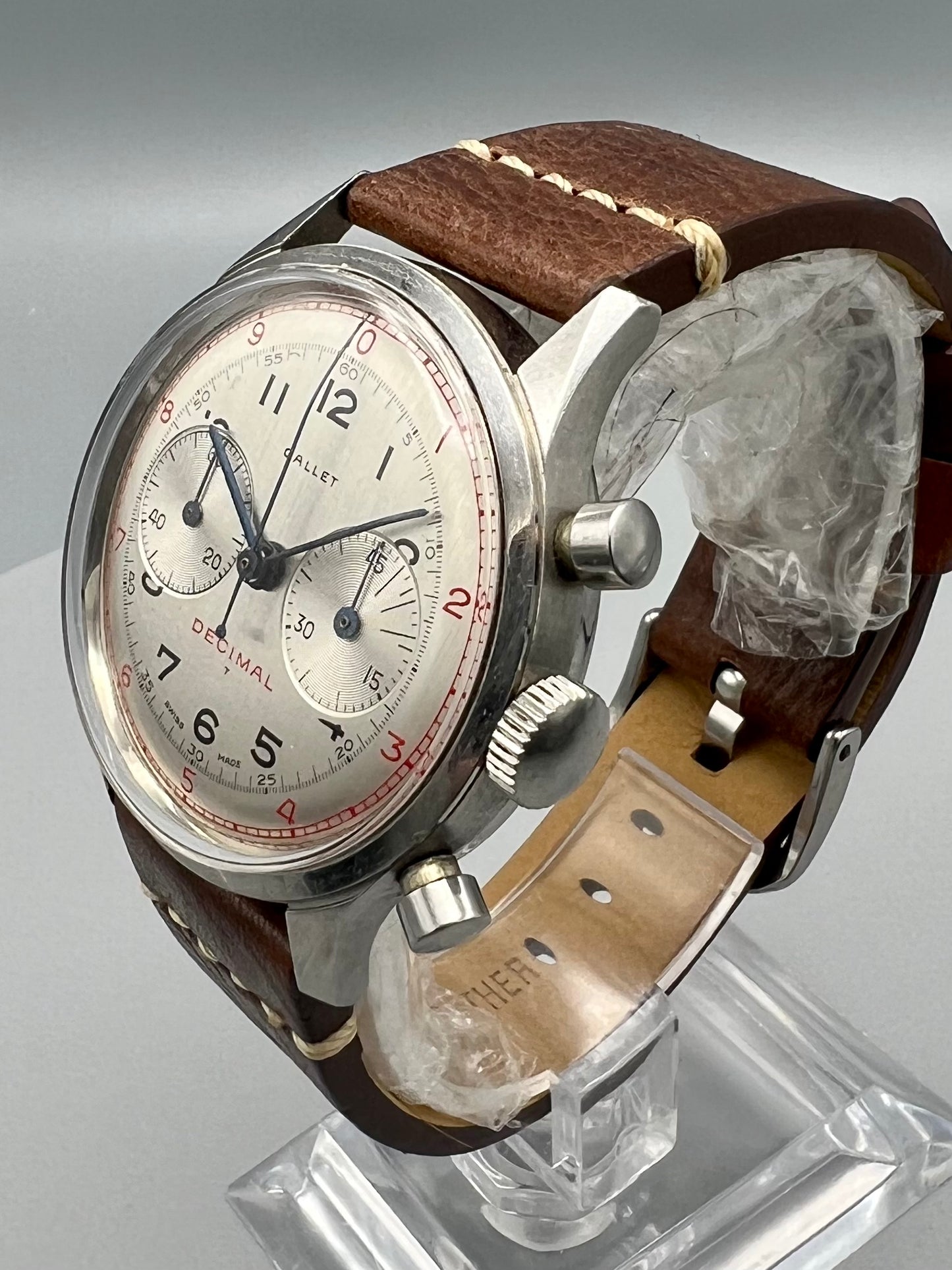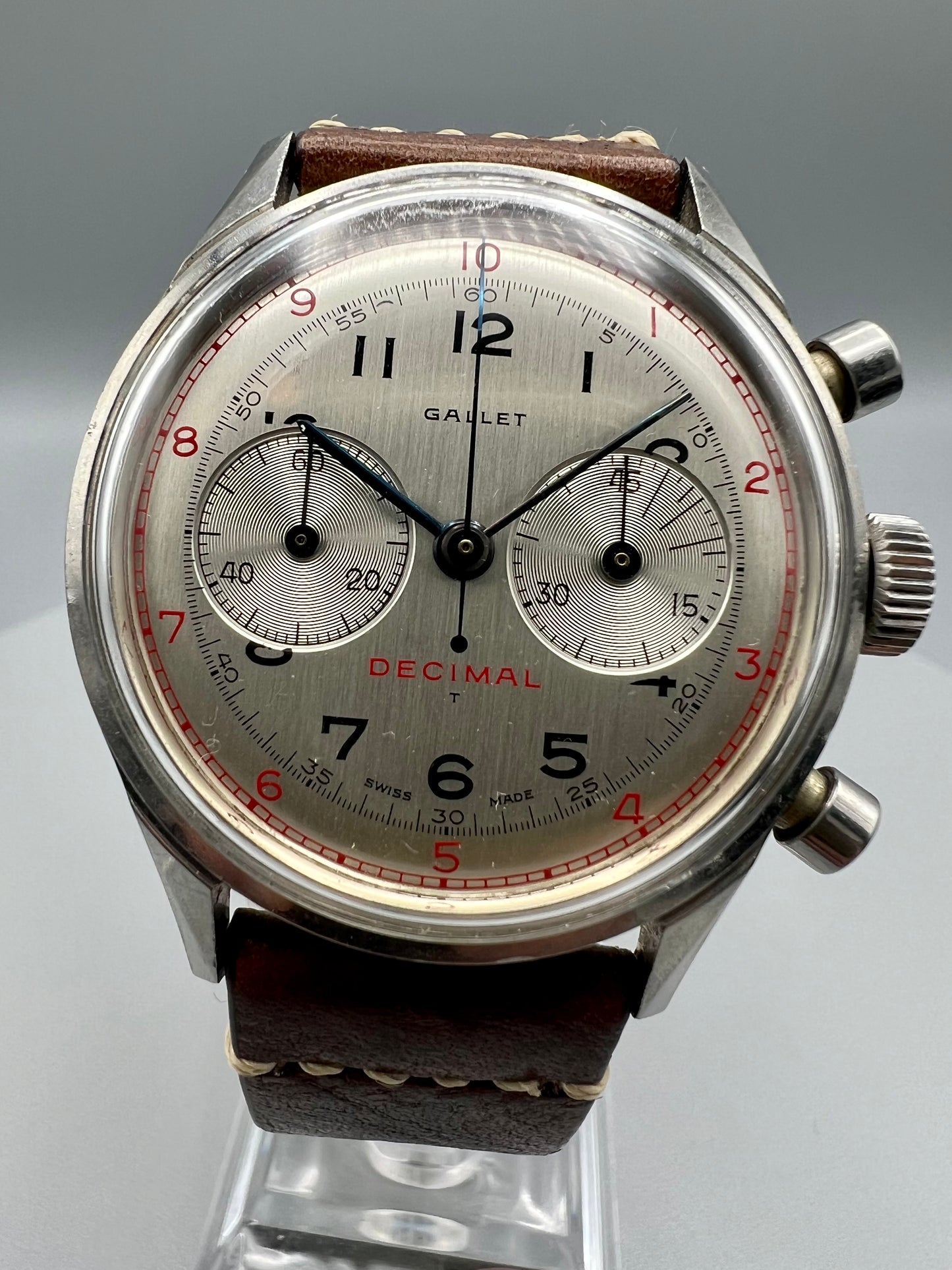>> Price: $7,750.00
Parthian Watch Company
Gallet Multichron Decimal Chronograph, Rare and Excellent Condition, 1950s
Gallet Multichron Decimal Chronograph, Rare and Excellent Condition, 1950s
Couldn't load pickup availability
This is a rare Gallet Decimal chronograph made in the grand decade of the Swiss watch industry. The model is named Decimal, because dial has two scales, with the red outer scale dividing the time in 1/100th of a minute and the inner scale the traditional 1/60th. The 1/100th scale is functional for scientific purposes – although the scale is useful in medical and sporting measurements also. The Decimal model was made in the 1950s within the Multichron family of Gallet, and to find one in such good condition after 70 years is rare.
This Gallet runs on the Excelsior Park P4 movement. That movement was designed in 1928 and manufactured until 1968. Excelsior Park was a highly respected chronograph specialist; and in addition to their own brand, they produced stop watches for Gallet, Zenith, and Girard-Perregaux.
Excelsior Park competed mainly with Martel who also produced movements for Zenith. In 1962, Martel was bought by Zenith, and without a steady customer, despite their excellent reputation Excelsior Park fell on hard times. The company eventually went out of business in the early 1980s.
The condition of this watch is remarkable: the original mint silver dial has brushed and circular patterns, which play nicely against daylight. The hands are blued steel.
The nicely proportioned 37mm case appears unpolished.
Movement: Excelsior Park P4
Jewels: 17
Size: 14’’’ ligne
Frequency: 18,000 VpH
Power Reserve: 32 hrs
History of Gallet
The Gallet family were clockmakers dating back to 1466, but Gallet & Cie was founded in 1826 in La Chaux-de-Fonds, Switzerland by Julien Gallet. In 1864, Gallet established its presence in the US in Chicago and 30 years later they Gallet introduced the first wrist-worn watches for mass consumption by men and women to the American market. These first "wristwatches" were unpopular due to public perception as being unusual for women and feminine for men. All unsold examples are soon returned to Switzerland for disassembly. In spite of initial resistance to this groundbreaking innovation, wristwatches were issued during WWI as a more useful way for soldiers to tell time in combat situations.
In 1912 Gallet created the first wristwatch for mass distribution and featured a full-sized constant second hand originating from the center of the dial. This innovation proved useful for timing tasks that emphasized seconds over minutes and hours, including the measuring of the human heart rate. Gallet’s new “sweep second” wristwatches were issued to military nurses and medics during World War I. Soon after, in 1914 Gallet supplies wrist-worn timers to the British armed forces during World War I. Gallet won the 1st place award for chronometer accuracy at the Canton Observatory in Neuchâtel in 1917.
Gallet’s Timekeeping innovations include:
1903: The first wristwatch
1914: The first wrist chronograph produced for the British RAF (the MultiChron)
1915: The first sweep center secondhand wristwatch
1928: The first wristwatch with a fast 28,800 BPH escapement (the Quick-Train)
1938: the first chronograph with a waterproof case
1943: the first chronograph with an additional 24 hr GMT hand
George Washington carried a Gallet pocket watch and harry Truman wore a Gallet Flight Officer chronograph while in office as 33rd president.






















